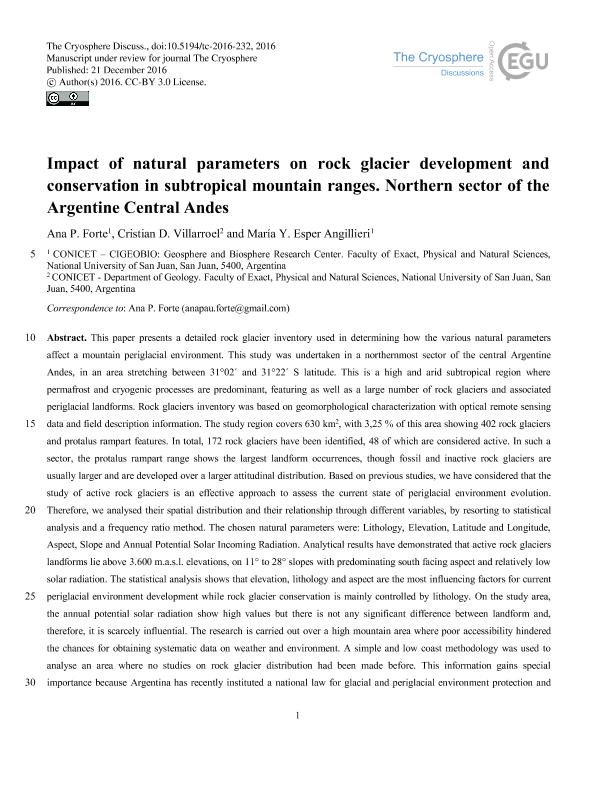Mostrar el registro sencillo del ítem
dc.contributor.author
Forte, Ana Paula

dc.contributor.author
Villarroel, Cristian Daniel

dc.contributor.author
Esper Angillieri, María Yanina

dc.date.available
2018-12-13T13:17:57Z
dc.date.issued
2016-12
dc.identifier.citation
Forte, Ana Paula; Villarroel, Cristian Daniel; Esper Angillieri, María Yanina; Impact of natural parameters on rock glacier development and conservation in subtropical mountain ranges. Northern sector of the Argentine Central Andes; Copernicus GmbH; The Cryosphere Discussions; 12-2016; 1-24
dc.identifier.issn
1994-0440
dc.identifier.uri
http://hdl.handle.net/11336/66391
dc.description.abstract
This paper presents a detailed rock glacier inventory used in determining how the various natural parameters affect a mountain periglacial environment. This study was undertaken in a northernmost sector of the central Argentine Andes, in an area stretching between 31°02´ and 31°22´ S latitude. This is a high and arid subtropical region where permafrost and cryogenic processes are predominant, featuring as well as a large number of rock glaciers and associated periglacial landforms. Rock glaciers inventory was based on geomorphological characterization with optical remote sensing data and field description information. The study region covers 630 km2, with 3,25 % of this area showing 402 rock glaciers and protalus rampart features. In total, 172 rock glaciers have been identified, 48 of which are considered active. In such a sector, the protalus rampart range shows the largest landform occurrences, though fossil and inactive rock glaciers are usually larger and are developed over a larger attitudinal distribution. Based on previous studies, we have considered that the study of active rock glaciers is an effective approach to assess the current state of periglacial environment evolution. Therefore, we analysed their spatial distribution and their relationship through different variables, by resorting to statistical analysis and a frequency ratio method. The chosen natural parameters were: Lithology, Elevation, Latitude and Longitude,Aspect, Slope and Annual Potential Solar Incoming Radiation. Analytical results have demonstrated that active rock glaciers landforms lie above 3.600 m.a.s.l. elevations, on 11° to 28° slopes with predominating south facing aspect and relatively low solar radiation. The statistical analysis shows that elevation, lithology and aspect are the most influencing factors for current periglacial environment development while rock glacier conservation is mainly controlled by lithology. On the study area, the annual potential solar radiation show high values but there is not any significant difference between landform and, therefore, it is scarcely influential. The research is carried out over a high mountain area where poor accessibility hindered the chances for obtaining systematic data on weather and environment. A simple and low coast methodology was used to analyse an area where no studies on rock glacier distribution had been made before. This information gains special importance because Argentina has recently instituted a national law for glacial and periglacial environment protection and conservation. Therefore, this research and its results may contribute a significant step toward knowing the number, features and distribution of rock glacier bodies lying in a scarcely studied region.
dc.format
application/pdf
dc.language.iso
eng
dc.publisher
Copernicus GmbH
dc.rights
info:eu-repo/semantics/openAccess
dc.rights.uri
https://creativecommons.org/licenses/by-nc-sa/2.5/ar/
dc.subject
Subtropical Mountain Permafrost
dc.subject
Permafrost Development And Conservation
dc.subject
Rock Glacier
dc.subject
Argentine Central Andes
dc.subject.classification
Meteorología y Ciencias Atmosféricas

dc.subject.classification
Ciencias de la Tierra y relacionadas con el Medio Ambiente

dc.subject.classification
CIENCIAS NATURALES Y EXACTAS

dc.title
Impact of natural parameters on rock glacier development and conservation in subtropical mountain ranges. Northern sector of the Argentine Central Andes
dc.type
info:eu-repo/semantics/article
dc.type
info:ar-repo/semantics/artículo
dc.type
info:eu-repo/semantics/publishedVersion
dc.date.updated
2018-09-27T20:16:23Z
dc.journal.pagination
1-24
dc.journal.pais
Alemania

dc.journal.ciudad
Göttingen
dc.description.fil
Fil: Forte, Ana Paula. Consejo Nacional de Investigaciones Científicas y Técnicas. Centro Científico Tecnológico Conicet - San Juan. Centro de Investigaciones de la Geosfera y Biosfera. Universidad Nacional de San Juan. Facultad de Ciencias Exactas Físicas y Naturales. Centro de Investigaciones de la Geosfera y Biosfera; Argentina
dc.description.fil
Fil: Villarroel, Cristian Daniel. Consejo Nacional de Investigaciones Científicas y Técnicas. Centro Científico Tecnológico Conicet - San Juan; Argentina. Universidad Nacional de San Juan. Facultad de Ciencias Exactas, Físicas y Naturales. Departamento de Geología; Argentina
dc.description.fil
Fil: Esper Angillieri, María Yanina. Consejo Nacional de Investigaciones Científicas y Técnicas. Centro Científico Tecnológico Conicet - San Juan. Centro de Investigaciones de la Geosfera y Biosfera. Universidad Nacional de San Juan. Facultad de Ciencias Exactas Físicas y Naturales. Centro de Investigaciones de la Geosfera y Biosfera; Argentina
dc.journal.title
The Cryosphere Discussions
dc.relation.alternativeid
info:eu-repo/semantics/altIdentifier/doi/https://doi.org/10.5194/tc-2016-232
dc.relation.alternativeid
info:eu-repo/semantics/altIdentifier/url/https://www.the-cryosphere-discuss.net/tc-2016-232/
Archivos asociados
